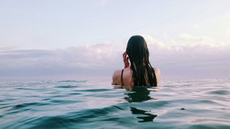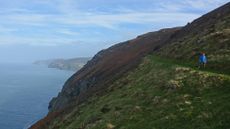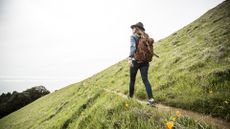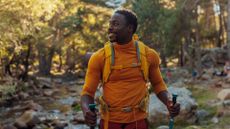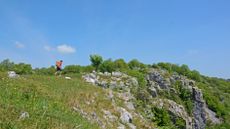The best hiking backpacks offer comfort, versatility and plenty of storage options for day walkers and long-distance trekkers. Once upon a time, hiking backpacks were great big, robust things made from canvas and steel, with leather straps for affixing muskets and machetes. Thankfully, today's top hiking backpacks are very different: they are lightweight, highly technical pieces of advanced kit.
Don't let choosing your rucksack be an afterthought. While you might be focusing on picking up the best backpacking tent for your trip or making sure you've got the best hiking boots for the terrain you're tackling, if your rucksack is wrong, it can ruin an otherwise meticulously planned expedition. Make sure whatever pack you choose is adjusted correctly to your body shape before you set off – here's exactly how to fit a backpack properly to avoid doubt.
Best hiking backpacks to buy now right now
Why you can trust T3 Our expert reviewers spend hours testing and comparing products and services so you can choose the best for you. Find out more about how we test.

The North Face Trail Lite Backpack is the ideal size for an overnight hike for two people (if they're happy to travel light) or one person who likes to take everything with them when they're out and about.
Thanks to the many pockets and compartments, you can keep all your trail equipment organised regardless of their size. Large bits can go in the main compartment and the stuff pockets on the outside, while smaller items can be hidden away in the zipped pockets found on the top lid and the hip belt.
You won't have to worry about the bag getting wet, either, thanks to the DWR finish that can withstand light showers and some rain (we had the 'pleasure' of testing this feature on my hikes).
And while you might expect a large hiking backpack with so many pockets to feel uncomfortable the more you wear it, we experienced no discomfort at all while using The North Face Trail Lite Backpack. The adjustable back panel, the dual-density foam around the hip belt and the soft and supportive shoulder straps ensure you'll never want to put the bag down ever again.
Read our full The North Face Trail Lite Backpack review.


For our money, the best hiking backpack right now is the Osprey Tempest Pro (for men) and Osprey Talon Pro (for women). This excellent backpack will give you all the storage you need for a big day out as well as features that you'll appreciate if you're hitting the mountains and fells. For big days out, you'll find hydration pack compatibility as well as loops for ice axes and trekking poles; these packs also feature well-designed strap systems that'll fit you snugly all day.
The Tempest Pro gives you 28 litres of storage, while the Talon Pro can hold up to 30 litres, enough for everything you might need for a long day's excursion. Bear in mind, though, that at around a kilogram in weight, these might be a bit heavy if you're planning on keeping up the pace. They're water-resistant enough to withstand all but the heaviest downpour and tough enough for most eventualities. In short, either could easily become your favourite hiking companion.
Read our full Osprey Tempest Pro 28 / Talon Pro 30 backpack review


The Brenta is one of Vaude's bestselling backpacks, and even in its smallest configuration – we tested the 24L version in our review – it packs in plenty of features that you'd normally only find on bigger hiking backpacks. It has a height-adjustable back with hip and chest straps for better weight distribution, as well as an 'Aeroflex 3D suspension system' that uses mesh to keep the main body of the pack away from your back for extra breathability.
This isn't a casual backpack for taking to the office; features such as an integrated rain cover, a flap for a platypus tube and a hoop for holding a walking pole are all evidence that this is for serious hiking; naturally, there is all manner of pockets for stashing your gear. It's water-repellent and made from 50% recycled polyester, and crucially it's easy to adjust and comfortable for all-day wear in the great outdoors.
Read our full Vaude Brenta hiking backpack review


A bit big for a daypack and not quite roomy enough for a week away, Fjallraven's Abisko Friluft 35 is the perfect size for a two-day adventure in the outdoors. Its 35-litre capacity plus an extendable top lid means that you can comfortably pack for two days way (or even three if you pack light), and it comes with plenty of additional pockets for stashing all your bits and bobs. While it's not waterproof, you can add some extra water resistance by treating the fabric with Fjallraven’s Greenland Wax, and it comes complete with a rain cover to protect it should you hit a downpour, while its waterproof bottom panel will help keep it dry on wet ground.
It looks great, and it's comfortable to wear for extended periods. However, we'd be wary of choosing the pale blue colourway as it attracts dirt like nobody's business. Go for the black or dark green instead, and you'll be rewarded with a weekend pack that ticks all the boxes.
Read our full Fjallraven Abisko Friluft 35 review


If you can stomach the extravagant price point, the limited edition Osprey Antigravity 64 UNLTD has a lot going for it. The bag features a 3D-printed PU back panel that's springy and flexible and does a great job of allowing your back to stay cool and sweat-free, even over an extended hike. It's well-specced with plenty of pockets and straps for everything you might need to carry, as well as a compression compartment for your sleeping bag and even room for a water reservoir.
At 64 litres capacity, it's not small, and despite the name, it's not especially lightweight, weighing in at almost 3kg. The Osprey Antigravity 64 UNLTD is weatherproof if not quite waterproof, and if you need a rucksack that offers tip-top performance for long-distance adventures, it's definitely up to the job, although we expect the price will put many off.
Read our full Osprey Antigravity 64 UNLTD backpack review


A more traditional hiking rucksack design, the Snow Peak Active Backpack Type 01 ONE boasts a decent 43 litre capacity, more than enough for multiple days on the trail, hut-to-hut excursions and short camping jaunts. The two separate areas of storage help keep the contents organised, one accessible from the top, one via a zipped rear section, and with an outer of water-resistant nylon it'll shrug off all but the heaviest downpours.
The super-wide hip belt should soak up much of the load-carrying work, and also has zipped pockets for trail essentials – handy for a soft flask and snacks to keep you fuelled on the go. On the downside, this is a heavier bag than we'd like (just under 2kg for the bag alone), and the price point is on the high side. However, if you're looking for that traditional dual-storage area hiking rucksack in tasteful tactical black, this is well worth checking out.


The Berghaus Alpine 45 keeps things simple, as well as the costs down, making it a strong contender in our best hiking backpack ranking. With a 45-litre capacity, you’ve plenty of space for any adventure but not enough to be tempted into taking the kitchen sink along. Neat side compression straps keep the clean lines intact even when in use, with plenty of additional attachment points for poles, skis, tents and a reflective bungee for that extra layer you’ve just taken off.
A simple roll-top enclosure will keep the worst of the weather at bay and is easily managed wearing gloves, while the back support is removable if shaving those extra grams is a priority. Low-profile straps and a slim-line hip belt reduce faff to the minimum without reducing comfort, and there’s even a small zipped pocket for essentials too. In short, there's everything you need here for a great day out and nothing you don't. Sounds good to us…
Make sure you check our Berghaus discount codes to pick up a saving.


The bigger version of the same line we have in the top spot on this list, the Osprey Talon 55 (for men) and Tempest 50 (for women), is an excellent option for multi-day adventures. In our review, our tester praised how lightweight, comfortable and supportive it was in use. There is a large top-loading compartment with zippered side access, and to keep things organised internally, there's another small base compartment that can be separated using the in-built divider.
The detachable floating top lid can be used to add volume. A headline feature is the back system, which is fully adjustable and extremely breathable too. If you're after a versatile mid-sized pack that looks stylish, can hold a decent amount of outdoorsy kit, and will last, this is a great choice.
Read our full Osprey Talon 55 / Tempest 50 review


First, off the bat, let's be clear – the Berghaus Fast Hike 32 is no big load carrier. Wannabe Amundsens should avoid. However, almost everyone else should be interested, as this is a bit of a smasher – very, very light, but a decent size for most excursions. It's even strippable for extreme lightness, should an extra 100 grams really make the difference (it probably won't, but nice to have the option).
Essentially what Berghaus has done here is produce a rucksack with the high-end alpine features of an extreme sports rucksack, but at a sensible price point and without using kevlar or graphene, to save a few grams. In short, you could buy a more expensive bag, but it'll be no better for the job, and if you buy a cheaper one, it'll weigh a ton – this is a bit of a sweet spot.
32-litre capacity is plenty for summer rambles, more serious single-day hikes, and perfectly good for hut-to-hut adventures in the alps. You'll get your commute cycle kit in it too, and it's small enough not to cause a fuss around town, as well as fitting in an overhead locker if needs be. Obviously, there's a hip belt, hydration sleeve, side bottle pockets and a soft flask front harness pocket to boot. And it's suitable for both men and women, too. In short, a hiking backpack that's ideal for almost all occasions.


The Mammut Lithium Crest packs in all the features you could possibly want, as well as a few new ones, but without breaking your back or your wallet. Weighing in at a mere 1.7kg, the Lithium sports daisy chains, loops for a mat, three side and front pockets, and axe and pole attachments. It's also hydration system compatible and incorporates a raincover. The back length is easily adjustable, which is helpful if you’re wearing bulkier clothes in the winter, or if you’re sharing one heavy rucksack between a mixed party to make faster progress. There’s plenty of space here for days worth of stuff, and with a separately accessible bottom compartment you have a fighting chance of being able to find things easily.
How to choose the best hiking backpack for you
Hiking is all things to all people, so getting the right balance between weight, size and robustness is key, especially for something you’ll be wearing on your back for many days in total. Modern materials mean that ye olde steel frame rucksacks are broadly unnecessary, unless you're in training and want to carry the extra weight. Here are some things to look for when choosing the best hiking backpack for you:
Volume
Arguably the most important starting point. How much do you really need to carry? Summer rambling along the coast requires a different set of kit to winter wild camping, but don’t get carried away and buy a giant windsock of a thing that needs an SAS team to carry once filled.
Fit
Check and check again that the rucksack fits your back well. Most makes have different back sizes available, so try a few on with both a light load and a heavy one (most shops have weight bags for this). If there's a hip belt, this should rest on the top of your hip bones, and adjust to a comfortable tightness – this can transfer a lot of weight from your shoulders to your hips, so don't underestimate the importance of a well-fitting hip belt. And of course, none of this is any good if the straps aren't adjusted correctly: here's how to fit a backpack.
Comfort
Walk around and move naturally to see if anything rubs or feels weird. By all means try the super-techno suspended mesh solutions to getting a sweaty back, but rest assured after a long day with a heavy rucksack, your back will be sweaty, so don't prioritise them over a really good fit.
Weight
Lighter is nearly always better, and that often means the minimum of random bells and whistles, which all add weight. Don't be afraid to cut off straps and fastenings you know you'll never use.
Pockets and straps
Think about what you'll need to carry, and how accessible you'll need it to be. Streamlined designs might look smart, but when you're having to unpack the whole thing to access your torch in the middle of the evening, pockets start to look more appealing.
FAQ
Which hiking backpack materials perform the best?
Modern hiking backpacks are made from whatever fabric you desire, from Dyneema and kevlar to canvas and steel. There is usually a compromise somewhere in materials, but also that simple, tried, and tested materials are unlikely to disappoint you. In contrast, that experimental new kevlar weave might delaminate in strong sunlight.
Although DWR coatings are helpful to avoid fabric wetting out and adding weight, covers and special 'waterproof' closures tend not to work in actual outdoor weather, so are best ignored. Remember, the actual ultralight hiking backpacks on the market will wear out quickly, so it's probably wise to pick a slightly more robust model with durable materials. But, again, your planned use is the key to choosing the right blend of weight versus durability.
What's the best size for a hiking backpack?
One of the main things you need to establish before you even start looking for the best hiking backpack for your adventures is the carrying capacity you require, which is dictated mainly by how long you travel. Roughly, you need 20-15L bags for single-day hikes, around 30-50L for overnight stays and over 50L for long backpacking expeditions. Where you opt for the top or bottom end of the scale will depend on how light of a packer you are, the time of year you're travelling and what activities you're doing.




